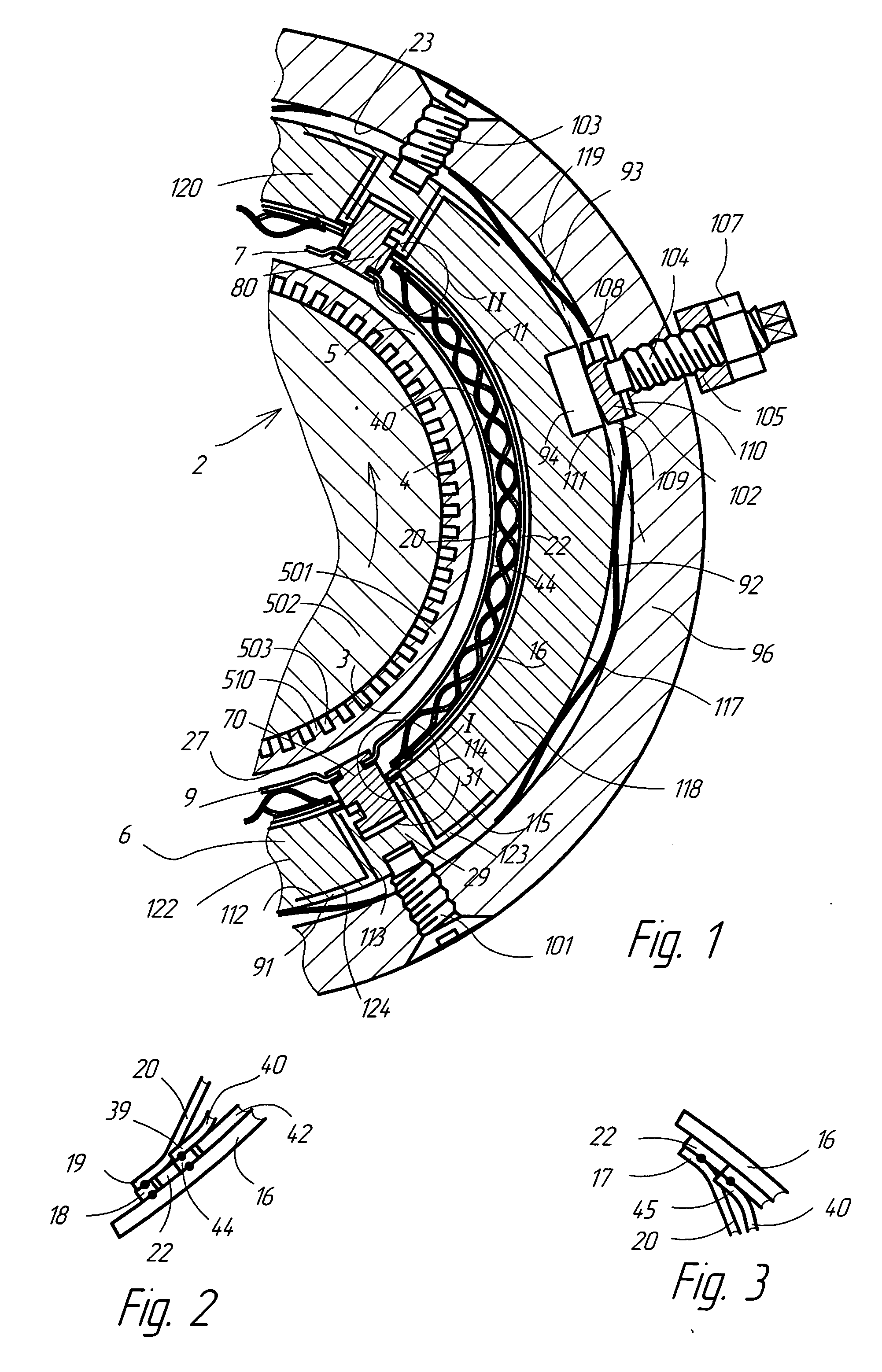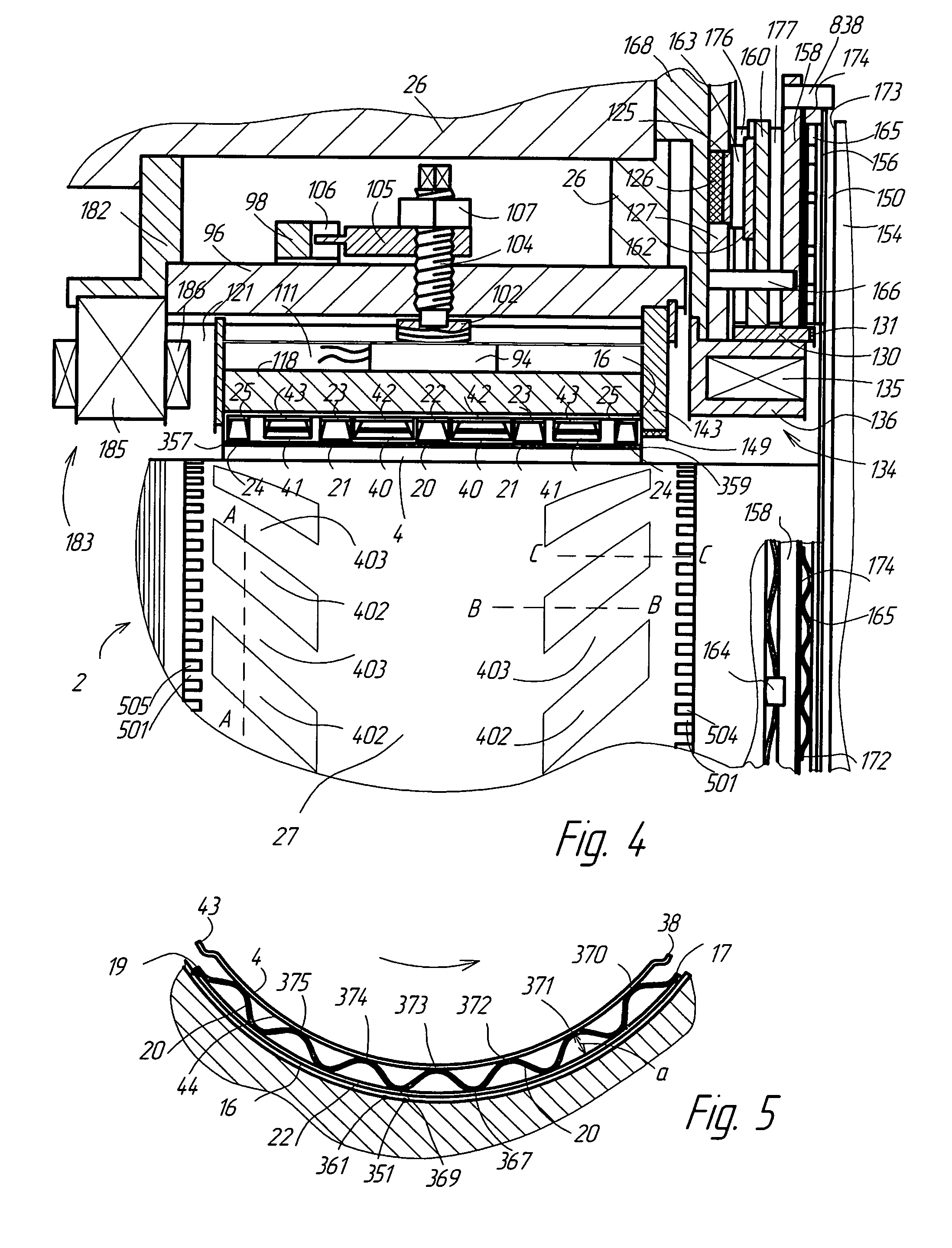For a conventional foil bearing, having one or several bump foils, there is a determined bearing load damaging the bump foil (damaging load), i.e. when plastic deformation of one or several bump foils starts.
Normally the damaging load is significantly more than the bearing
load capacity.
However this method is not suitable for a conventional wave-shaped bump foil.
Coating the compliant membrane by a rigid wear-resistant layer is sufficiently difficult because connection of the
coating with the membrane must be durable.
Thereby the rigid wear-resistant antifriction
coating is not practically used in conventional foil bearings.
Making grooves in a soft
coating, normally used for foil bearings, is rather difficult and moreover under operating conditions such grooves can change their shape.
However in this case it is difficult to meet requirements for the optimal number of the grooves, which number is desirable to be more than ten, a more number of the grooves causes decreasing as lengths of the bump foils as damping thereof.
Using such a rotor in the foil bearing with a compliant top foil, having a soft antifriction coating, causes an intense antifriction coating wear under start / stop or under short-time
impact loads, or other big random loads exceeding the bearing
load capacity.
However the passive bearing preload has a limitation because increase in bearing preload causes increasing
contact pressure of the top foil to the rotatable member and
dry friction therebetween, therefore wear increases under rotor start / stop.
Such a bearing has limited possibilities to increase the bearing preload due to a small top foils'
bending stiffness.
However under increase in bearing preload there slightly increases damping of the
lubrication film because thickness of the lubrication film between each top foil and the journal decreases in a narrow zone disposed opposite a contacting surface of the pin with the top foil.
Using such pushing pins in the foil bearing with the bump foil does not provide growth in damping and worsens the bearing characteristics because the top foil has a small thickness and will bulge in the zone of contact with the pushing pins thereby decreasing the bearing
load capacity.
However rather a big volumes of air cameras exceedingly decrease stiffness and damping of such a bearing.
However construction of such a bearing does not allow controlling bearing preload under operating conditions thereby limiting possibilities to increase the
bearing stiffness and damping.
Disadvantage of such an anchoring of the top foils is necessity to distance leading and trailing parts thereof from the journal thereby decreasing a useful length of the top foil as well as the necessity of a complicated (as a
cam) form of the housing member inner surface.
Disadvantage of such a manner of anchoring is a small circumferential stiffness of an anchoring part for reason of rather a big radial distance between the point of anchoring the foil and a
line of action of the
tangential force, dragging or pushing the top foil under rotor start / stop in operating conditions of
dry friction in the bearing or during an accident when aforesaid force can be too big thereby deforming the top foil at the point of anchoring.
As previously discussed, under a big bearing load, considerably exceeding the bearing load capacity, conventional foil bearings can be damaged because of plastic deformation of a bump foil.
Such damaging of the bump foil causes increasing a mounting gap, decreasing the
bearing stiffness and damping and appearing possible journal oscillations of big amplitude,
grazing rotor rotating parts and decreasing
machine service life (machine life).
Such a limitation of the journal eccentricity provides decreasing a torque of friction in the foil bearing under rotor start.
However under operating rotation speed, external loads to the rotor, appearing, for example, under machine housing oscillations, can often cause a more journal eccentricity than its static eccentricity thereby causing contact of the rotating journal and the ball rolling bearing inner ring.
At a big circumferential journal speed (about several tens m / sec) such frequent contacts can cause damaging contacting surfaces and decreasing the bearing service life.
However
disadvantage of such a double radial bearing is contact of the journal with the ball rolling bearing inner ring and therefore wear of the contacting surfaces, which contact occurs under a considerably less load than the foil bearing load capacity for reason of compliance of a bearing top foil.
That is why a significant part of the cooling air, running between the top foil and the housing member, is slightly heated and ineffectively used.
However efficiency of such a cooling is limited.
Under a big durational load the axial foil bearing has difficulties with cooling because the heat generated in the lubrication film is too big but such problems are missing in axial active magnetic bearings.
Such oscillations are accompanied with
dry friction between bearing foil elements.
Under growth in amplitude of the oscillations,
rubbing elements' wear can become significant thereby reducing the machine service life.
At a small rotation speed foil bearings have a small load capacity, thereby increase in rotor weight causes a significant
bearing wear under rotor start / stop.
Thus the auxiliary bearings have a small
operating life during accidents.
Magnetic bearings are badly tailored to
impact loads and high-frequency oscillations while foil bearings are well tailored to such conditions.
Despite aforesaid advantages of the
hybrid bearing, comprising the foil bearing and the
magnetic bearing, such a construction has serious disadvantages, namely
high complexity and high cost.
Magnetic bearings are significantly more expensive than foil bearings because of a very complicated
magnetic bearing control system and expensive electronic components.
Great cost of the highly complicated
magnetic bearing control system is connected with providing high speed and complexity of
data processing about position of the rotor to transmit controlling signals to the
magnet bearings and to accommodate forces acting to the rotor with
high frequency and prevent appearing of
instability causing rotor oscillations in the magnetic bearings.
However therein a complicated magnetic bearing
control system is almost completely used for such
hybrid bearings while the foil bearings well operate without such a
system under forces acting to the rotor with
high frequency.
However such a bearing does not provide a regular
load distribution to all the
bushing tilting parts in the circumferential direction because load to the
bushing part closest to the thrust disc is more than that to a bushing part disposed at the opposite thrust disc side, i.e. the maximally outlying part.
However in U.S. Pat. No. 4,296,976 there is not referred to possible decrease in gas leakage through the bearing by means of disposition of the bump foils' ridges.
Similar mutual disposition of the bump foils, which ridges are circumferentially extended, does not provide significant decrease in gas leakage through the bearing, which serves as a seal.
Disadvantage of this seal is that by means of the top foil sealing tubular part the pressure between the top foil and the bump foil does not practically vary in the radial direction and the pressure is equal to the
gas pressure nearby the top foil inner
diameter.
It may be
disadvantage, for example, in case of a small sized foil bearing.
For axial bearings, which
diameter is about 20 millimeters or less, for example, such a wave length does not allow arranging between the top foil and the housing member a sufficient number of
waves to form the optimal lubrication film profile.
However radial bearings of high-speed machines for transport applications may have big loads for a sufficiently long time, about several seconds, for example, because of the gyroscopic torque impacting to the rotor.
 Login to View More
Login to View More  Login to View More
Login to View More 


